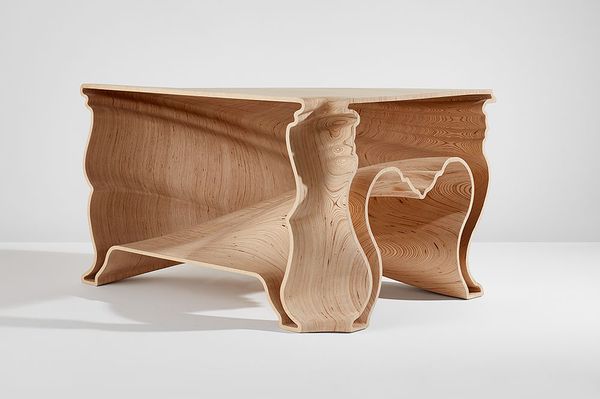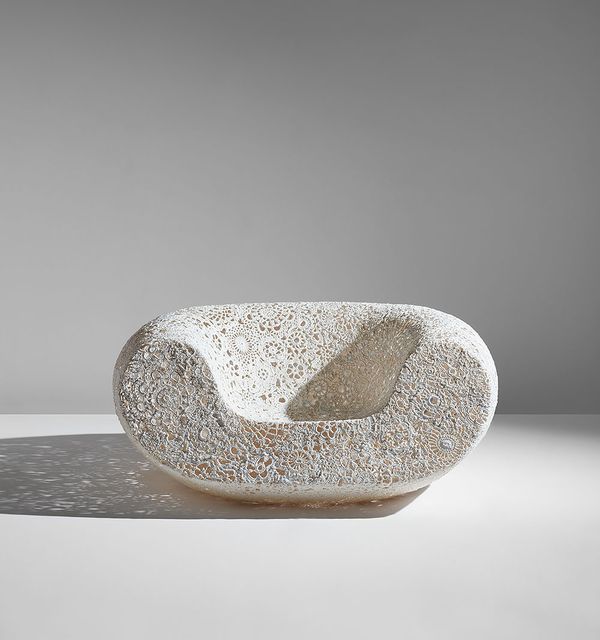Portrait of Gijs Bakker, 2011. Copyright Ilco Kemmere Fotografie.
I don’t believe in looking forward, it does not exist. I look here and now. —Gijs Bakker
Rob Driessen: Dutch design is a brand: the Dutch government promotes it as an export product, alongside cheese and tulips. Has it become a cliché?
Gijs Bakker: I don’t think so, at least not outside the Netherlands. Mind you, the term Dutch Design is not that old; between 1993 and 2000 Droog Design was the central concept. Only by the team that we had had exhibitions all over the world, even in Tokyo and Shanghai, people started referring to it as Dutch Design, to acknowledge it as a broader concept. That change was very gradual and logical.
RD: What makes Dutch Design stand out from other design movements or centers?
GB: In my opinion the source, or the central figure, was Jan Lucassen, the former director of the Eindhoven Design Academy. His appointment in 1986 laid the foundation of what we know now as Dutch Design. Traditionally, all academies were divided into departments: furniture, ceramics, textiles, graphic design, in which the students were neatly making chairs, forming clay, et cetera. In Eindhoven that was completely cut loose. Under Lucassen’s supervision, the human being became the central focus around which eight themes were formulated: man and living, man and work, man and public space and so forth. In those days that was an insane thing to do: design was supposed to be industrial design; everything rotated around industry, the producer, the client. Not surprisingly, the Netherlands played no role whatsoever in design on a global scale. It was completely marginal, it came down to anonymous work by technical engineers. Lucassen changed that with his vision, and was a crucial factor in the making of a new generation of designers.
RD: One year after Lucassen took the helm in Eindhoven, you joined his teacher’s staff. Did his program fit you?
GB: I already had been teaching at Arnhem Academy for several years, developing my own ideas which corresponded with Lucassen’s philosophy. In Eindhoven I was in charge of the “living” program: instead of making some piece of furniture we tried to find answers to open questions such as: “what is living?” How do you inhabit a space, how do you interact with objects? What is that like now, how has it been in the past, how will it be in the future? This approach opened up new worlds of thought for me and my students, it stimulated creativity. Anything goes, you’re free. It seems so trivial, but it was essential, there was no book of rules. A totally different approach than Delft university, which I fled after teaching there for two years. In Delft everything was laid down in categories and protocols. When you followed those, something was bound to come out; that way everybody was capable of designing a perfectly acceptable flat-iron. Imagine that, in a time when Memphis already had been introduced in the Netherlands and had an enormous impact.
Jeroen Verhoeven, “Cinderella” table, 2004-2007.
RD: What was it about postmodernism that appealed to you? The irony, the playfulness?
GB: Sottsass and Mendini overturned all the rules. Take Italian furniture: it had degenerated into luxury, had become expensive, chic, exclusive. Sottsass and Mendini said: ‘”let’s turn that around, use banal materials, make a radical change.” They took action and I liked that. What Sottsass and his fellow postmodernists did came down to an aesthetic coup; they ran amok. Materials are sacred, so let’s cover them in a layer of plastic laminate. Decoration is not done, so let’s use it. Furniture design? Just stack a pile of colored blocks and call it a bookshelf. All norms of what was supposed to be good form were literally turned upside down. It was rebellious and at the same time very substantial. Mendini wrote very interesting views on architecture and design. It stimulated discussion.
RD: But when I look at your work I see pragmatism: no waste of material, no superfluous decoration. Quite different from what the postmodernists advocated for.
GB: It all comes down to the philosophy that as a designer you have to develop yourself into a freethinking artist. Don’t sit there waiting for an assignment but do something, realize your ideas on your own. Only when you’ve made the object you can show it to the world, communicate it. Then it will start to live, it will provoke reactions to which you can respond again. Don’t be a wallflower. As a teacher, I used this approach as well. I would gather a group of 12 to 20 students around a student’s work and discuss it in length. Everybody would join in, it was very stimulating.
You don’t critique someone’s work to tear it down, but to get to the core of that student to enable him or her to start building. —Gijs Bakker
RD: It sounds a bit like drama school or the conservatory, where you have to develop a thick skin against criticism. Did you want to teach your students to stand their ground?
GB: Exactly. You don’t critique someone’s work to tear it down, but to get to the core of that student to enable him or her to start building. At a certain point, a design is finished, it’s done. But then it has to be produced, in a way that doesn’t do harm to your design. So we taught the students to stand up for themselves. In classes and lectures I always provoke them by saying: “you’ll have to become famous!” And they look at me with big frightened eyes. But only then the commissions will come to you, they’ll want you. Industries have no clue whatsoever. They look if something or someone is successful and only then they will pick it up. So you have to get their attention. Not for you as a person, but to make sure that they see your work.
RD: Isn’t there a risk of pushing students into the spotlights too early?
GB: That is the reproach we got with Droog, that we exploited young talent. That was painful. We tried to challenge their talent, to bring it to fruition. Those young designers were not our product, they were the product of a generation and their shared background at the academy. Their formal language, their imagery immediately linked together. That is what you see now and what we recognized back then. When Renny Ramakers invited me to help her organize a show in Amsterdam in 1993, I took a new crop of students from Eindhoven and a few from Arnhem whose work I thought was interesting. And put together it had credibility, it had a certain stance.
RD: So that’s how Droog came to be. How did people respond to that strange Dutch term, “droog”?
GB: Well yes, that name. After I came up with it, Renny and I had to put up quite a struggle to hold onto it. It took some getting used to in Milan; German colleagues thought Droog referred to drugs, as in “die Drogen von Amsterdam.” That was kind of cool. And of course it was a jaw breaker for English speakers as well, but I was used to that with Gijs being my first name. Our only concession was putting “design” behind Droog. It was the perfect word for what we were trying to get across: it’s dry, unembellished, down to earth. For the artists and designers we were working with, the name was no problem at all, because it was picked up immediately after the introduction in Milan. It worked because the content, the products and the name exactly fell into place. That’s what they now call branding.
Marcel Wanders, “Crochet” chair, 2006.
RD: It caught on immediately but was there resistance as well? Did people not find Droog too dominant at a certain point?
GB: Some colleagues published pamphlets: “Droog acts like there is nothing but Droog and that’s bad for our profession!” I responded to that by saying: “Take advantage. You used to be unknown and now you can jump on the bandwagon.” Droog was not simply about showing existing works; soon we started to initiate projects, like the one that spawned the Knotted Chair by Marcel Wanders, my favorite Droog product. That chair was developed in close cooperation with the aeronautics and space department at Delft Technical University.
It all comes down to the philosophy that as a designer you have to develop yourself into a freethinking artist. —Gijs Bakker
RD: It takes some nerve to confront serious scientists with macramé, bobbin lace and crochet…
GB: Talking about the typical character of Dutch Design that’s exactly it; to bring something as lame and obsolete as macramé, which was absolutely not done in design, together with high-tech, the latest of the latest in fiber technology. That’s how you come to something completely new. Take the Heatwave radiator by Joris Laarman: while looking for the ideal way to circulate heat, he found it in the long-discarded form of the acanthus leaf motif. Like the knotted chair, the result was a fundamentally important product. Heatwave was Joris’s graduation project at Eindhoven for which he received full honors.
RD: Your own career was rocketed in an early stage as well, with the legendary show of radical jewelry you did with Emmy van Leersum at Stedelijk Museum in 1967. Did you develop a nose for success?
GB: Whenever I am working on a project and I don’t have the feeling that it’s going to be a success, it means that it’s not good enough and I terminate it. Not that it has to be a commercial success; I have a lot of ideas but I’m not a business man, far from it. I simply have to believe in something. That is what gives you power, although it’s not as powerful as it used to be now that I’m reaching eighty.
Maarten Baas, Set of four “Clay” chairs, 2006.
RD: You’re still very active: you work, you teach. How do you see the future of art and design?
GB: I don’t believe in looking forward, it does not exist. I look here and now. In general, people don’t look properly. We recognize things because we have seen them before somehow. Or we have heard from others that something is good, or beautiful. To really look is an art which we apply too little. Fashion designers always claim that they look ahead, but that’s all bullocks. What they do is look out of their window and see what the kids in the street are wearing. Not that it’s a bad thing. In the past, when my students and I wanted to design a chair, the other teachers commented: “but there already are so many chairs!” Then I used to say: “every new generation has the right to design its own chair.”
RD: The Futurists believed that new art could only blossom on the smoldering ashes of the work of previous generations. What is the heritage of Dutch Design? Can you imagine that ten years from now a young designer will challenge the Droog works, by burning them for instance?
GB: Maarten Baas actually burned two of my works: a Holes table and chair. But these were properly paid for by Murray Moss beforehand, so the whole thing was staged. Some expensive set of furniture that was… As for the icons of past and present: some moments in time will last forever. Of the thousands of products each generation makes, a few will surface. That goes for Droog too. Not many though, maybe like fifteen pieces. Icons can be very intimidating; I have to confess that for me as a designer, some of the classics from my days were pretty threatening. But they turned out to be building blocks, or even stepping stones. It’s not like one design replaces the other; it rather adds to the whole which becomes richer, deeper, more layered and substantial. Together it forms a solid ground for the next generation to build on.



